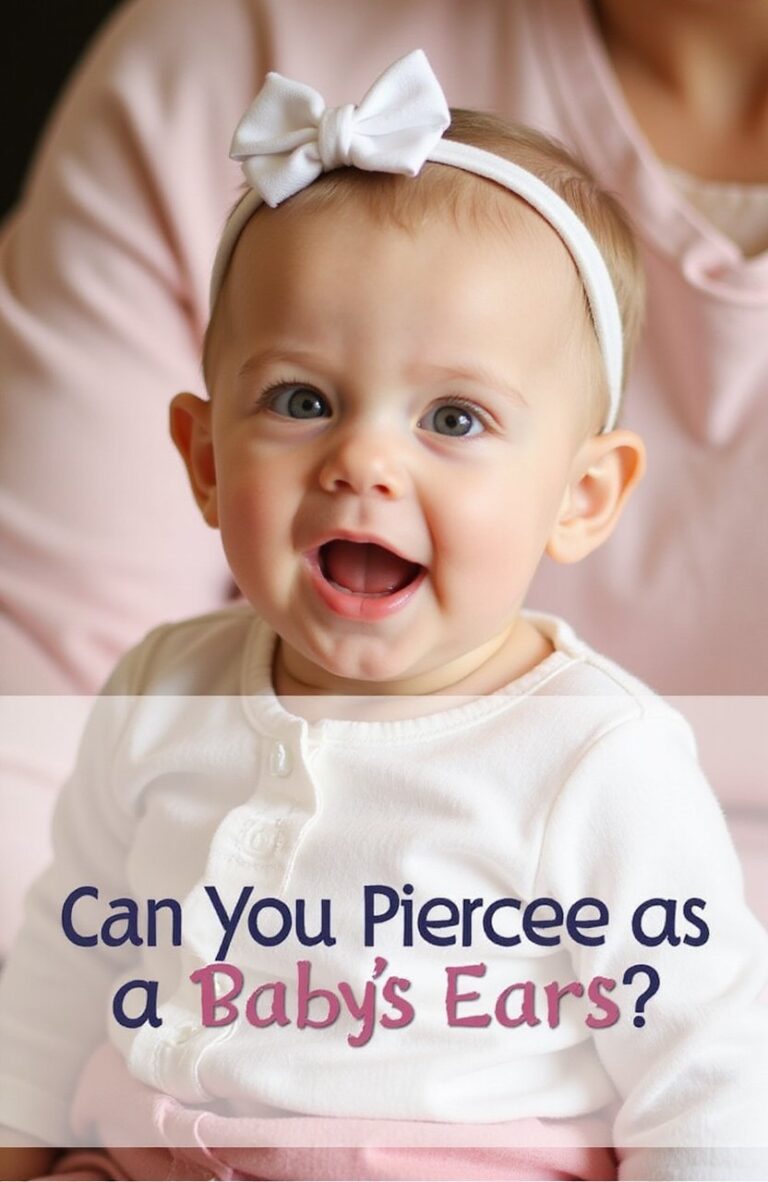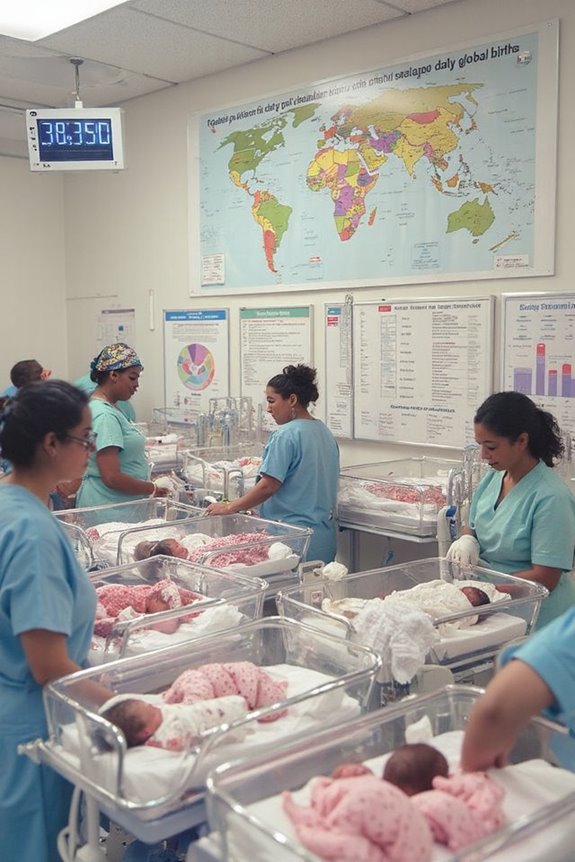Your baby will inherit approximately 50% of DNA from each parent, creating a unique blend of physical traits. Eye color, hair texture, and facial features are determined by complex genetic interactions including both dominant and recessive genes from multiple generations. While you might see yourself or your partner in your child, unexpected traits from grandparents or great-grandparents can appear. Though predictive AI technology exists, it can’t account for all genetic variables that will shape your little one’s appearance.
Key Takeaways
- Your baby will inherit approximately 50% of DNA from each parent, creating a unique blend of physical characteristics.
- Eye and hair color are determined by multiple genes, with dominant traits like brown eyes more likely to appear than recessive ones.
- Family photos can provide clues about inherited traits, as recognizable features often persist across generations.
- Environmental factors during pregnancy, including maternal nutrition and stress, can influence your baby’s physical development.
- While AI prediction tools exist, they cannot fully capture genetic complexity and should be viewed as entertaining possibilities rather than certainties.
Genetic Traits That Influence Your Baby’s Appearance
When you’re expecting a baby, it’s natural to wonder what your little one will look like. Genetic variability plays a major role in determining your child’s appearance, with traits coming from both parents and even distant ancestors.
Physical diversity in babies stems from polygenic traits—characteristics influenced by multiple genes working together. For example:
- Eye color isn’t simply dominant/recessive but involves several genes
- Skin tone results from complex genetic combinations
- Hair texture and color depend on multiple genetic factors
Family genetics provide clues about possible traits, but recessive genes can surprise you with features neither parent displays. While trait predictions can be made by examining family history, the exact outcome remains unpredictable.
Remember that environmental influences like nutrition and sun exposure can also affect how genetic traits express themselves after birth.
How Dominant and Recessive Genes Work
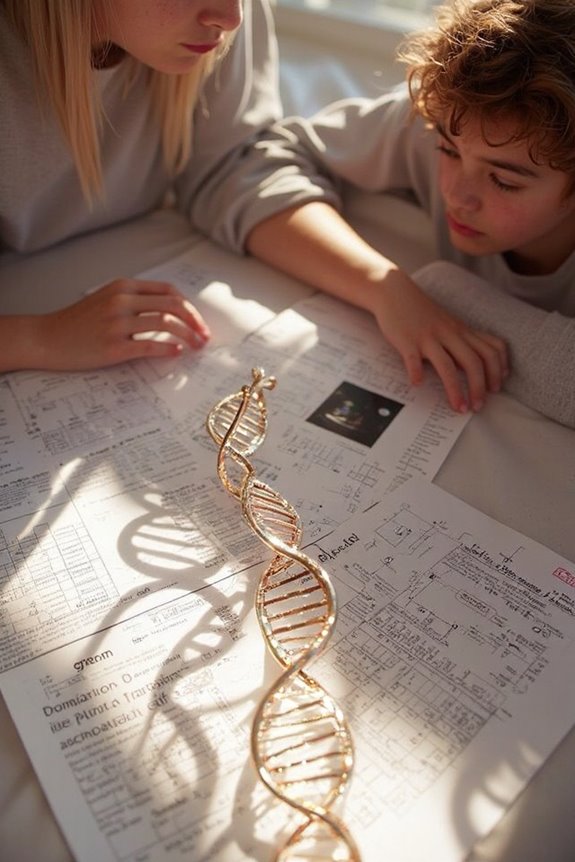
Understanding your baby’s genetic makeup goes beyond general inheritance patterns. When I counsel expectant parents, I explain that trait prediction depends on genotype interaction—how different versions of genes (alleles) combine.
In dominant-recessive inheritance:
- Dominant traits appear when at least one dominant allele is present
- Recessive traits only show when both alleles are recessive
- Allele combinations determine phenotype expression (visible traits)
For example, if you have brown eyes (dominant) and your partner has blue eyes (recessive), your baby has a higher chance of brown eyes. However, genetic variation creates surprises in family genetics.
Some genetic disorders follow predictable inheritance patterns:
- Autosomal dominant: Need only one copy (Huntington’s disease)
- Autosomal recessive: Need two copies (cystic fibrosis)
Remember that many traits involve multiple genes, making appearance predictions complex.
The Science Behind Eye and Hair Color Inheritance

The fascinating science of eye and hair color inheritance involves far more complexity than many parents realize. While you might expect simple patterns, the reality is that:
- At least eight genes influence eye color, with key players including OCA2 and HERC2
- Hair color depends on multiple genes plus environmental factors
- Brown eyes can result from six different genetic combinations
- More than 97% of blue-eyed individuals share a specific genetic pattern (H-1 haplotype)
Recent genome-wide studies have identified over 50 genetic loci associated with eye color and 150+ genes linked to eye color inheritance. Hair color is particularly unpredictable, with red hair involving specific mutations in MC1R gene. Blonde hair typically stems from mutations affecting melanin production.
Understanding these complex patterns helps explain why predicting your baby’s features isn’t straightforward.
Growth Patterns During Your Baby’s First Year
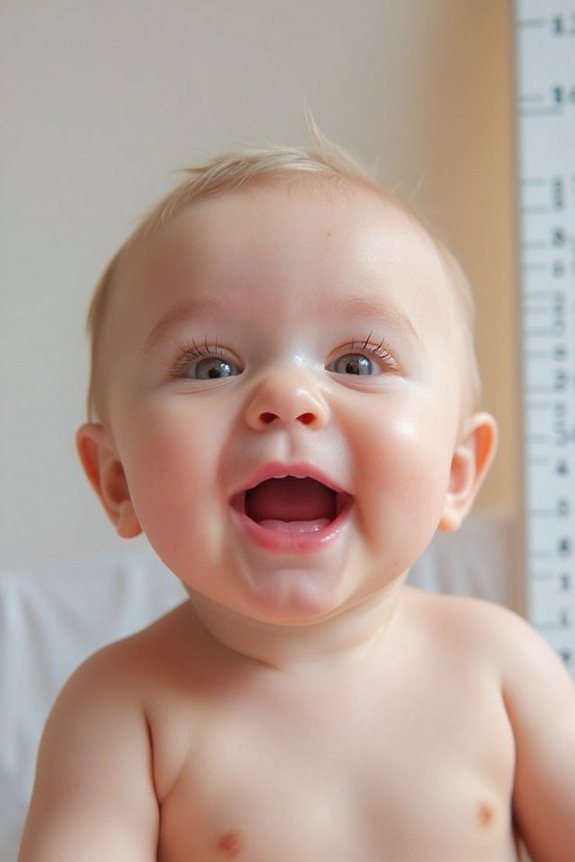
While you’re busy marveling at your newborn’s tiny features, their body is already preparing for remarkable changes in the months ahead. Your baby will initially lose 10-12% of their birth weight but should regain it by two weeks of age.
Growth happens rapidly during the first year:
- Weight will double by 4-6 months
- Expect 1.5-2 pounds of weight gain monthly early on
- By 2 months, girls typically weigh about 11 pounds 4 ounces; boys about 12 pounds 5 ounces
Your baby’s growth spurts will be accompanied by developmental milestones:
- Rolling over (around 5 months)
- Crawling (about 7 months)
- Recognizing familiar faces (by 6 months)
Remember that each baby follows their own growth curve, with differences between breastfed and formula-fed infants.
When Your Baby Will Start Looking Like “Themselves”
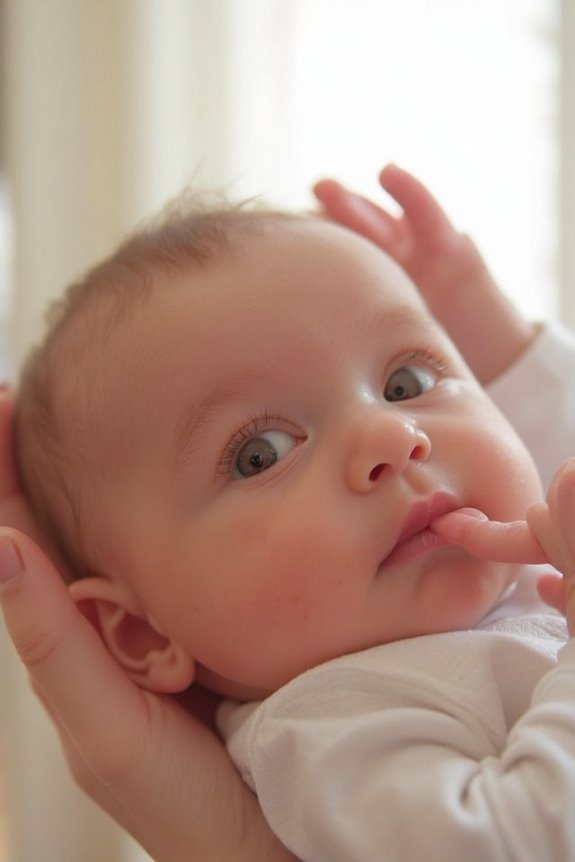
Parents often wonder when their baby’s face will take on its permanent characteristics beyond those first blurry newborn days. The journey toward a recognizable face involves several facial milestones that occur during the first year.
Around 3 months, babies gain better muscle control, allowing for intentional smiles and the beginning of expression evolution. By 6 months, their features become more defined and individual, with many parents noticing distinctive family traits emerging.
Key developmental phases:
- 3 months: Controlled facial expressions begin
- 6 months: Recognition of familiar faces develops
- 7 months: Emotional responses through expressions appear
Genetics play the primary role in your baby’s appearance, but environmental factors like nutrition and social interaction also influence facial development. By their first birthday, most babies have developed the facial characteristics that will follow them through childhood.
Facial Features: Nature vs. Nurture
Although genetics largely determines your baby’s facial features, environmental factors also play a crucial role in their development. Your baby’s appearance results from complex polygenic traits, with genetic influence accounting for approximately 80% of facial characteristics.
Both maternal genes and paternal genes contribute to your child’s unique look, though their specific balance remains understudied. Environmental impact becomes particularly significant during critical periods of development, when factors like nutrition and toxin exposure can affect facial symmetry and structure.
The interplay between genetics and environment follows intricate developmental pathways that shape your baby’s appearance. Social perception of facial features varies across cultures, though the fundamental genetic variability that makes each face unique transcends cultural boundaries.
Physical Similarities Between Siblings
The genetics that shape a baby’s facial features also determine how similar siblings will look to each other. While siblings share approximately 50% of their DNA, the way these genes express themselves can vary dramatically from child to child.
Sibling resemblance stems from this shared genetic material, particularly in traits like eye color, facial structure, and hair texture. However, genetic diversity guarantees that each child receives a unique combination of chromosomes from their parents.
Consider these factors affecting sibling appearance:
- Only identical twins share 100% genetic material
- Environmental factors like nutrition influence physical development
- Complex traits involve multiple genes interacting together
- Shared family environment can amplify similarities
This explains why some siblings look strikingly similar while others barely resemble each other, despite sharing the same parents.
Factors That May Alter Your Baby’s Predicted Appearance
While family photos and genetic calculators might give you an idea of your baby’s potential looks, numerous factors can greatly alter these predictions.
Environmental influences during pregnancy play a significant role in your baby’s development. Your nutrition, stress levels, and exposure to certain substances can impact how genes express themselves. For instance:
- Maternal diet can affect birth weight and facial development
- UV exposure can influence skin characteristics like freckles
- Prenatal conditions may alter growth patterns
Epigenetic factors also modify gene expression without changing DNA sequences. These modifications can be triggered by:
- Environmental toxins
- Maternal stress
- Nutritional status
Remember that your baby’s appearance will also evolve substantially after birth, with features like eye color potentially changing during infancy and more dramatic changes occurring throughout childhood and adolescence.
Family Resemblance Through Generations
Looking beyond immediate environmental factors, your baby’s appearance will also reflect family resemblance patterns that span generations. This fascinating genetic inheritance follows predictable mathematical patterns:
- Your baby inherits approximately 50% of their DNA from each parent
- About 25% comes from each grandparent
- Roughly 12.5% derives from each great-grandparent
These generational traits manifest in various physical characteristics like eye color, facial features, and body structure. Family genetics creates a blend that’s uniquely your child’s while maintaining recognizable family traits.
When examining family photos, you might notice how certain features persist through generations. This is due to Mendelian inheritance patterns and multifactorial traits that combine genetic influences with environmental factors. The expression of these inherited traits ultimately creates your baby’s distinctive appearance within your family’s genetic framework.
Using Technology to Predict Your Baby’s Appearance
Have you ever wondered if modern technology can give you a glimpse of your future child’s face? Today’s AI predictions use complex algorithms to create images based on parental traits and genetic information.
Digital imaging and predictive modeling tools analyze facial features to generate possible appearances of your future baby. These technologies include:
- Age progression software that simulates how a child may look at different life stages
- Forensic DNA phenotyping that predicts physical traits from genetic data
- Facial recognition systems that blend parental characteristics
While fascinating, these technologies raise important questions about genetic privacy and technology ethics. The data accuracy varies widely, and results should be viewed as entertaining possibilities rather than definitive predictions. Genetic diversity means many factors influence your baby’s actual appearance that AI cannot fully capture.
Frequently Asked Questions
When Will My Baby’s Fontanelles (Soft Spots) Close Completely?
I’m so excited to share about your little one’s precious journey! Your baby’s fontanelle closure varies: the posterior soft spot typically closes by 2-3 months, while the anterior one usually seals between 13-24 months.
Can My Baby’s Eye Color Change After the First Year?
While it’s less common, I’ve seen that eye color changes can occur after age one. Eye color genetics stabilize mostly by 9 months, though subtle shifts in your baby’s color change timeline may continue until age three.
Do Birth Marks Fade or Disappear as Babies Grow?
I just noticed my son’s birthmark fading. Yes, many birth mark types fade or disappear as babies grow. Some vascular ones vanish completely, while pigmented ones may persist. Gentle skincare tips help too!
Will My Baby’s Hair Texture Change After Their Initial Hair Falls Out?
Yes, I’d expect your baby’s hair texture to change after initial hair loss. Hair growth patterns vary naturally, with texture variations being common. The new growth often looks different from their newborn hair.
Can Environmental Factors Affect My Baby’s Skin Tone Development?
Ever wondered what shapes your little one’s appearance? While skin tone genetics primarily determine your baby’s complexion, environmental influences like sun exposure can affect development over time. Their true color stabilizes around 20 months of age.
References
https://www.healthychildren.org/English/ages-stages/baby/Pages/Physical-Appearance-and-Growth-1-To-3-Months.aspx
https://www.merckmanuals.com/home/children-s-health-issues/growth-and-development/physical-growth-of-infants-and-children
https://www.healthychildren.org/English/ages-stages/baby/Pages/Physical-Appearance-and-Growth-8-to-12-Months.aspx
https://www.merckmanuals.com/professional/pediatrics/growth-and-development/physical-growth-of-infants-and-children
https://mlpp.pressbooks.pub/lifespandevelopment1720/chapter/physical-growth-and-development-in-newborns-and-toddlers/
https://www.parents.com/getting-pregnant/genetics/tests/baby-looks/
https://www.thebump.com/a/what-will-my-baby-look-like
https://communities.springernature.com/posts/genes-influence-infants-preference-to-look-at-faces
https://www.familyeducation.com/family-life/relationships/history-genealogy/my-baby-looks-nothing-like-me-a-genetic-explanation-0
https://sneakpeektest.com/blog/5-traits-that-babies-get-from-their-mother-only/


